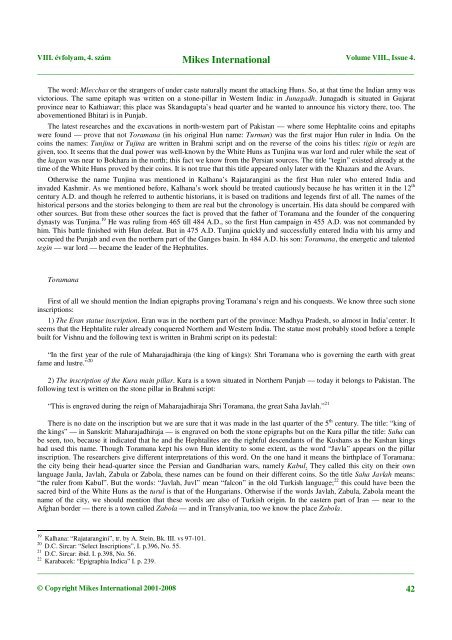Mikes International - Hollandiai Magyar Szövetség
Mikes International - Hollandiai Magyar Szövetség
Mikes International - Hollandiai Magyar Szövetség
Create successful ePaper yourself
Turn your PDF publications into a flip-book with our unique Google optimized e-Paper software.
VIII. évfolyam, 4. szám <strong>Mikes</strong> <strong>International</strong> Volume VIII., Issue 4.<br />
_____________________________________________________________________________________<br />
The word: Mlecchas or the strangers of under caste naturally meant the attacking Huns. So, at that time the Indian army was<br />
victorious. The same epitaph was written on a stone-pillar in Western India: in Junagadh. Junagadh is situated in Gujarat<br />
province near to Kathiawar; this place was Skandagupta’s head quarter and he wanted to announce his victory there, too. The<br />
abovementioned Bhitari is in Punjab.<br />
The latest researches and the excavations in north-western part of Pakistan — where some Hephtalite coins and epitaphs<br />
were found — prove that not Toramana (in his original Hun name: Turman) was the first major Hun ruler in India. On the<br />
coins the names: Tunjina or Tujina are written in Brahmi script and on the reverse of the coins his titles: tigin or tegin are<br />
given, too. It seems that the dual power was well-known by the White Huns as Tunjina was war lord and ruler while the seat of<br />
the kagan was near to Bokhara in the north; this fact we know from the Persian sources. The title “tegin” existed already at the<br />
time of the White Huns proved by their coins. It is not true that this title appeared only later with the Khazars and the Avars.<br />
Otherwise the name Tunjina was mentioned in Kalhana’s Rajatarangini as the first Hun ruler who entered India and<br />
invaded Kashmir. As we mentioned before, Kalhana’s work should be treated cautiously because he has written it in the 12 th<br />
century A.D. and though he referred to authentic historians, it is based on traditions and legends first of all. The names of the<br />
historical persons and the stories belonging to them are real but the chronology is uncertain. His data should be compared with<br />
other sources. But from these other sources the fact is proved that the father of Toramana and the founder of the conquering<br />
dynasty was Tunjina. 19 He was ruling from 465 till 484 A.D., so the first Hun campaign in 455 A.D. was not commanded by<br />
him. This battle finished with Hun defeat. But in 475 A.D. Tunjina quickly and successfully entered India with his army and<br />
occupied the Punjab and even the northern part of the Ganges basin. In 484 A.D. his son: Toramana, the energetic and talented<br />
tegin — war lord — became the leader of the Hephtalites.<br />
Toramana<br />
First of all we should mention the Indian epigraphs proving Toramana’s reign and his conquests. We know three such stone<br />
inscriptions:<br />
1) The Eran statue inscription. Eran was in the northern part of the province: Madhya Pradesh, so almost in India’center. It<br />
seems that the Hephtalite ruler already conquered Northern and Western India. The statue most probably stood before a temple<br />
built for Vishnu and the following text is written in Brahmi script on its pedestal:<br />
“In the first year of the rule of Maharajadhiraja (the king of kings): Shri Toramana who is governing the earth with great<br />
fame and lustre.” 20<br />
2) The inscription of the Kura main pillar. Kura is a town situated in Northern Punjab — today it belongs to Pakistan. The<br />
following text is written on the stone pillar in Brahmi script:<br />
“This is engraved during the reign of Maharajadhiraja Shri Toramana, the great Saha Javlah.” 21<br />
There is no date on the inscription but we are sure that it was made in the last quarter of the 5 th century. The title: “king of<br />
the kings” — in Sanskrit: Maharajadhiraja — is engraved on both the stone epigraphs but on the Kura pillar the title: Saha can<br />
be seen, too, because it indicated that he and the Hephtalites are the rightful descendants of the Kushans as the Kushan kings<br />
had used this name. Though Toramana kept his own Hun identity to some extent, as the word “Javla” appears on the pillar<br />
inscription. The researchers give different interpretations of this word. On the one hand it means the birthplace of Toramana:<br />
the city being their head-quarter since the Persian and Gandharian wars, namely Kabul. They called this city on their own<br />
language Jaula, Javlah, Zabula or Zabola, these names can be found on their different coins. So the title Saha Javlah means:<br />
“the ruler from Kabul”. But the words: “Javlah, Juvl” mean “falcon” in the old Turkish language; 22 this could have been the<br />
sacred bird of the White Huns as the turul is that of the Hungarians. Otherwise if the words Javlah, Zabula, Zabola meant the<br />
name of the city, we should mention that these words are also of Turkish origin. In the eastern part of Iran — near to the<br />
Afghan border — there is a town called Zabola — and in Transylvania, too we know the place Zabola.<br />
19 Kalhana: “Rajatarangini”, tr. by A. Stein, Bk. III. vs 97-101.<br />
20 D.C. Sircar: “Select Inscriptions”, I. p.396, No. 55.<br />
21 D.C. Sircar: ibid. I. p.398, No. 56.<br />
22 Karabacek: “Epigraphia Indica” I. p. 239.<br />
_____________________________________________________________________________________<br />
© Copyright <strong>Mikes</strong> <strong>International</strong> 2001-2008 42

















